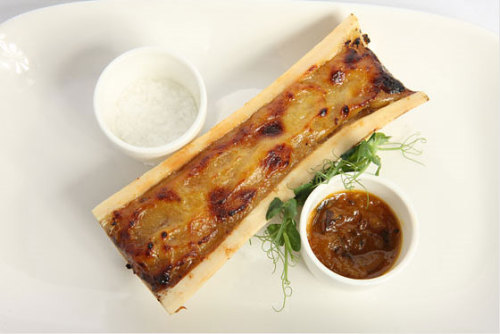
So, something I sometimes like doing (and did last night a bit) is eat / chew on the chicken wing bone.. and specifically the bone marrow. Tyler called me on it and asked why? Yeah, I know it's weird. I'm now looking up if it's healthy at all (which was my initial instinct) or just stupid.
Nutritional data of caribou marrow (very high in fat... monounsaturated though!)
For centuries my Sicilian family has always had "Bone Garlic Soup" on hand to treat darn near any illness. It's a simple recipe, a pot of water, 1 Chicken, 6 heads of garlic (chopped coarse) and 6 onions (also chopped coarse) If you want to add a cut up carrot or two that's fine. Boil it all for a few hours, adding water as it reduces. Pull the chicken out, and pull the meat off the bones. Cut up the bones and return to the broth. Boil for another few hours and pour through finer and finer sieves until you have an almost clear liquid. Pour off the fat and sip like tea.

--
Below, via a $5 'Google Answers' question 7 years ago.
It seems that bone marrow was very important in the diet of earlier
civilizations.
According to a study presented at the Indiana University website
(http://www.indiana.edu/~origins/teach/P380/proteins.html),
“Historically, native American hunters would pass up a thin bison
carcass, rather than eat lean muscle... or just eat the fatty bits.
This is also one reason why BONE MARROW is a very popular
food among foragers -- a great source of lipids & kcal. We will
read, later, about the implications of this type of behavior for
interpreting the patterns of meat eating among early human
hunters and scavengers.”
In a report titled, “The Evolution Of Human Nutrition”, by Barry
Bogin, which appears at the website of the Center for Instructional
Technology Development at the University of Toronto Scarborough
Campus (http://citd.scar.utoronto.ca/ANTAO1/Projects/Bogin.html),
the author states the following:
“Subsequent analysis shows that hominids may have been collecting
bones for their marrow and brain tissue rather than for any meat still
remaining on the surface of the bone (Binford 1987). Marrow and brain
are high in fat and protein, but few carnivores have the morphology
necessary to break open large long bones.”
In an article listed at the British Broadcasting Corporation (BBC)
website titled, “Ape-Man; Adventures in Human Evolution”,
(http://www.bbc.co.uk/science/apeman/chronology/2_5.shtml), the
following is stated:
“As Prof. Leslie Aiello (University College London) points out, bone
marrow is highly nutritious, and contains many important elements for
brain growth and development. It also takes much less energy to digest
than plant food. Scientists have shown that brain size was beginning
to increase in the later australopithecines, and it could all be down
to bone marrow as brain food.”
At a website called Unknowncountry.com, I found an article titled
“Meat Eating More Healthy in Prehistoric Times”, dated 28-Mar-2002.
(http://www.unknowncountry.com/news/?id=1385), in which the
author states,
“This rules out farmed foods such as dairy products, refined cereals,
added fats and salt. Instead, we should eat lean meat, fish, fresh
fruit and vegetables. The best parts of the meat are the oily brain
and bone marrow, since these are rich in healthy fats.”
It was more difficult to find discussion of the nutritional value of
bone marrow to modern humans. I did find many websites selling
nutritional supplements containing bone marrow as well as many
recipes.
Louis Arkson Inc., a manufacturer of Health Food Supplements and
Skin Care products, sells a product called Vita-Bone Marrow (
http://www.arkson.com/health/vbone.htm ). They state the following:
“Bone Marrow is the essence of all vertebralis. It contains all of the
necessary nutrients to the human body, such as proteins, vitamins,
complex B, minerals (calcium , magnesium, zinc ). Bone Marrow also
contains Lecithin and Methionine.
The result is a formula displaying the following properties:
Helps maintain healthy cholesterol level
Anti-inflammatory
Antispasmodic(*)
Promotes a strong immune system”
(*) An antispasmodic (synonym: spasmolytic) is a drug or an herb
that suppresses spasms.[1][2] These are usually caused by smooth
muscle contraction, especially in tubular organs. The effect is
to prevent spasms of the stomach, intestine or urinary bladder.
(Looks like for mostly involuntary muscles.. )
From Wikipedia:
Many cultures utilize bone marrow as a food. The Vietnamese prize bone as the soup base for their national staple phở; Alaskan Natives eat the bone marrow of caribou and moose; Indians use slow-cooked marrow as the core ingredient of the Indian dish Nalli Nihari; Mexicans use beef bone marrow from leg bones, called tuetano, which is cooked and served as filling for tacos or tostadas; it is also considered to be the highlight of the Italian dish ossobuco (braised veal shanks). Though once used in various preparations, including pemmican, bone marrow has fallen out of favor as a food in the United States. In the Philippines, the soup "Bulalo" is made primarily of beef stock and marrow bones, seasoned with choice vegetables and boiled meat.
Diners in the 18th century used a marrow scoop (or marrow spoon), often of silver and with a long thin bowl, as a table implement for removing marrow from a bone.
--
Hmm.. seems like mostly anecdotal evidence... still, whateves...
good enough for me. At least it doesn't seem bad for you. Plus,
large sourceof monounsaturates:
- Fights breast cancer, cholesterol (heart disease and strokes),
lowers the chances of gallstone formation, and what's this;
reduced belly fat??!!
Also, apparently I am now starting to believe everything
I read on the internet...






